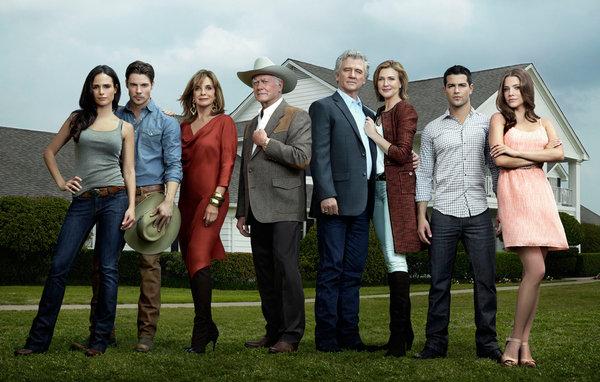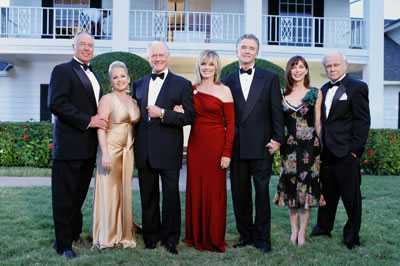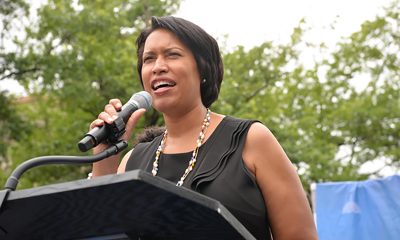Arts & Entertainment
‘Dallas’ reboot in fine form
Continuation of classic series deftly balances old and new
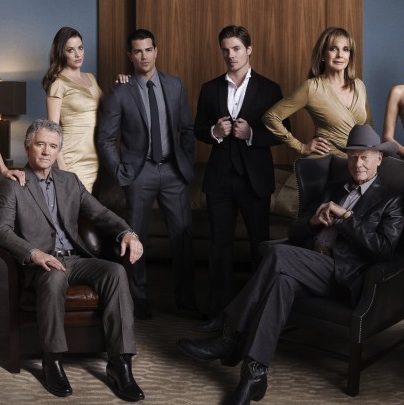
I finally caught the “Dallas” reboot (Wednesdays at 9 on TNT) last night on DVR — busy week — and though thoroughly prepped for disappointment, was delighted to find a tightly paced, deftly edited take on one of my all-time favorite shows that struck a perfect balance between edgy/hip/new and familiar/nostalgic/endearing.
Which is saying a hell of a lot — classic franchise reboots are notoriously hard to pull off. They always sound good on paper but when a show takes on a life of its own and becomes a cultural touchstone, as the ’78-’91 classic installment did, it’s practically impossible to catch lightening in a bottle twice. Who knows if it will last, but this week’s two-hour pilot did everything it needed to do to relaunch the series in a gripping, promising way. It’s light years better than “J.R. Returns” (1996) and “War of the Ewings” (1998), the two TV movies that continued the storyline and thankfully removed the bitter aftertaste left by the show’s bizarre 1991 finale (“Conundrum”) in which Joel Gray appeared in an “It’s a Wonderful Life” takeoff that ended with a shoddily ill-conceived cliffhanger with supernatural overtones.
So it’s thrilling to see the old warhorse, which struggled mightily in both quality and ratings its last few seasons, doing well — 6.9 million viewers tuned in to this week’s launch making it the most-watched scripted cable series so far this year and outranking anything the regular networks had in its time slot.
Twin heartthrobs Josh Henderson and Jesse Metcalfe play Ewing offspring John Ross (J.R. and Sue Ellen’s son) and Christopher (Bobby and Pam’s son) all grown up. One can’t help but wonder, of course, what became of Ormi Katz and Joshua Harris, the two actors who played the characters for years as kids on the original show, but their absence is quickly forgotten as Henderson and Metcalfe are so easy on the eyes and good actors too.
John Ross wants to drill for oil on Southfork Ranch against the wishes of Miss Ellie’s will. Christopher is pursuing an alternative energy venture that has had devastating consequences in Asia. He’s about to get married at the ranch to Rebecca (Julie Gonzalo). His old flame Elena (Jordana Brewster) is now dating John Ross. It’s a clever premise reviving a theme from the original series — early in the show, one of JR.’s deals left the family in a precarious spot financially and Miss Ellie had reluctantly agreed to let them drill on the ranch, something she’d never wanted to do. At the 11th hour, they didn’t have to.
The older generation is still kicking, though barely in some cases. Bobby (Patrick Duffy) is battling a cancer diagnosis (he’s married now to a third wife, Ann, played by Brenda Strong) and J.R. is in a nursing home suffering from depression. Sue Ellen (Linda Gray) is also in the cast. Cliff Barnes (Ken Kercheval) will be in future episodes. Ray Krebbs (Steve Kanaly) and Lucy Ewing (Charlene Tilton) are sadly reduced to cameos. Let’s hope if the show is a hit, they’re invited back and fleshed out. Tilton, especially, is a fan favorite from years ago. I never had Lucy’s hair but I did appreciate her taste in men — from gay Kit Mainwaring to her hunky doctor husband Mitch (Leigh McCloskey).
“Dallas” 2012 works for several key reasons — one, it’s been long enough now since the original show ended, that it feels fun, not tired, to revisit these characters. Nobody can say how long has to pass for such things to make sense, but pop culture very much unofficially dictates there has to be significant time — decades — before such ideas can float. “J.R. Returns” and “War of the Ewings,” while fun to watch, felt like everyone was beating a dead horse, and few horses were more dead than “Dallas” in its last couple regular seasons when most of the original cast had either long defected or were reduced to glorified cameos or mentions. The reboot, however, manages to revive the long-dormant excitement the show lacked in its final years by casting charismatic young actors in the key roles — Henderson and Brewster especially stand out — but having enough of the original cast around to keep it all grounded in authenticity. Using the original Texas-based exteriors, where several reunions have taken place over the years, is as key as the presence of Hagman, Duffy and Gray.
Sadly, but unsurprisingly, Victoria Principal (whose Pam was the original series’ central character in its early years) is a no show. She hasn’t fully shunned the show that made her famous — she showed up for a classic Vanity Fair photo shoot in the mid-’90s and for the 2004 “Return to Southfork” reunion (which featured cast members in a non-scripted format appearing as themselves), but has eschewed any thoughts of reviving her role. She told Ultimate Dallas (ultimatedallas.com, the amazingly thorough fan site) a few years ago the notion seemed rather absurd this many years later. Even so, she was never as chummy with the rest of the cast (Hagman, Duffy and Gray are close friends in real life and gathered regularly even before the show relaunched).
If Principal seems only vaguely interested — Duffy told TV Guide last week they talked by phone recently and she wished him the best on the new show — she’s still more involved than the late Barbara Bel Geddes (Miss Ellie) was in her final years. Not only did she sit out the last season (having left once before but come back), she was a no-show for both the TV movies, the Vanity Fair photo shoot and the 2004 reunion (she may have been ill for the latter — she died of cancer in 2005). She wasn’t, however, entirely reclusive in her later years — she did memorable commentary for a “Vertigo” restoration (she played Midge in the ’58 Hitchcock classic) in ’96. It’s a shame. She and Howard Keel (whose Clayton Farlow was a staple for 10 seasons), now both dead, would have been great additions to the Vanity Fair gathering. People always remember Jock (the late Jim Davis), but Clayton was on the show far longer.
The key to the new show’s success will be the degree to which it manages to maintain this delicate balancing act of old and new. Focus too much on J.R., Sue Ellen and Bobby and it looks like a Motown revival tour. But conversely, if the younger cast gets all the air time, there’s no anchor to the past. The scenes in which the two generations interacted were the best on Wednesday’s premiere — Hagman, who at age 80 has lost none of the lip-smaking relish he brought to what should have been an Emmy-winning role, plays especially well with Henderson, whose John Ross is presented as a manipulative chip off the old block.
A short scene by the Southfork pool with Henderson and Gray was the debut’s best. As Sue Ellen offered her son her support in the never-ending battle over the land (a recurring theme in the original series), Gray’s delivery crackled with tension. She looks amazing. Her icy glares shoot the same daggers they did all those years on the original series.
There were a few shoddy elements — the soundstages that are supposed to be the Southfork interiors lack both the floorplan and dimensions of those of the old show (which themselves did not match the interiors or layout of the real Southfork ranch where the exteriors have always been filmed) — but where it really counts, the new “Dallas” works. Even the opening credits, featuring a savvy twist on the original montage and a deliciously effective re-orchestration of the show’s majestic theme music, work.
It’s off to as solid a start as could possibly be expected.
Theater
D.C. theater scene has something for everyone this holiday season
‘Nutcracker,’ ‘A Christmas Carol,’ and much more
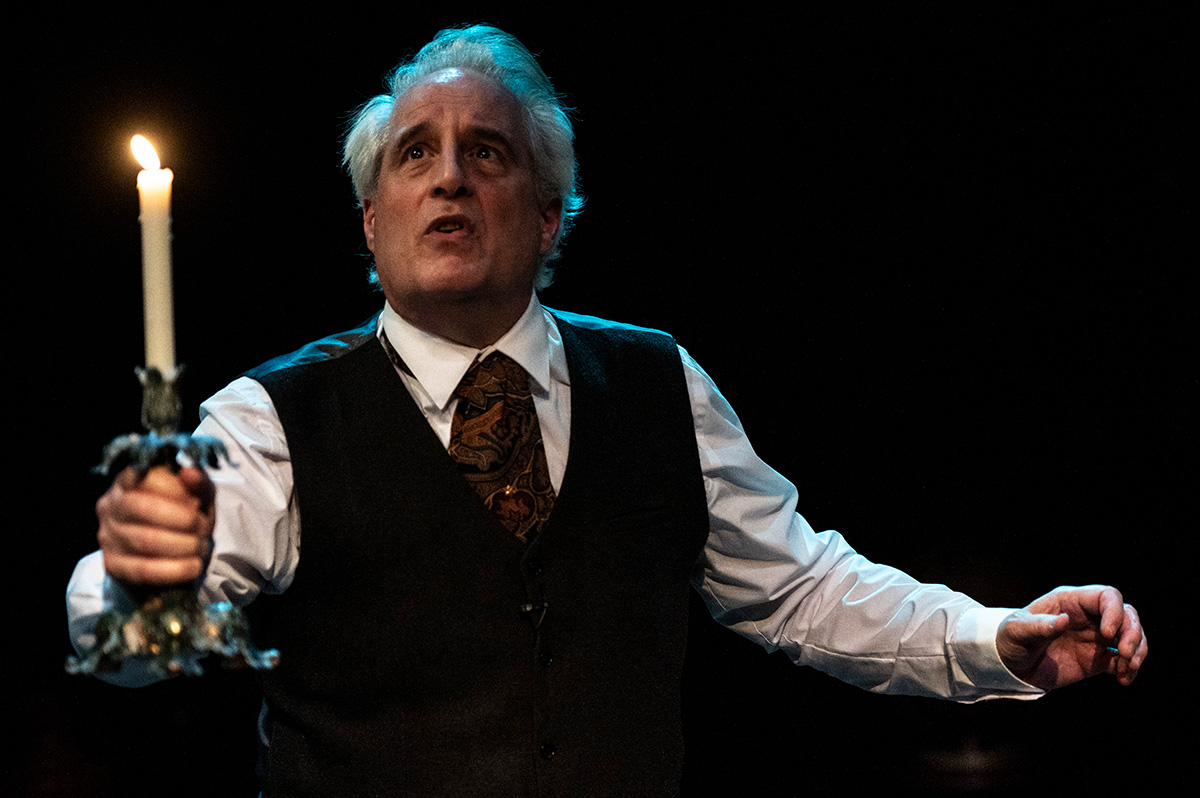
With its familiar music, yuletide imagery, and storytelling, theater can be a big part of the holidays. Add to that making memories and theater tickets wrapped as presents under the tree, and it’s a seasonal no brainer.
Folger Theatre presents “Resplendent Joy: Christmas Traditions from Spain and Portugal” (Dec. 5-14); the marvelous Folger Consort will perform early Spanish Christmas carols and traditional holiday music from early modern Spain and Portugal: folger.edu/resplendent
At Round House Theatre, playwright Sam Holcroft’s “Rules for Living” (Dec. 3-Jan. 4) makes its U.S. premiere. The darkly funny holiday comedy was a hit in London and is now hoping to repeat that success with a version tailored for the states. The seven-person cast includes versatile actors Naomi Jacobson and real-life spouse John Lescault. Ryan Rillette directs. roundhousetheatre.org
Theatre J presents “Chanukah in the Dark” (Dec. 6-21), an hour-long play ideal for ages five and up. “When the lights go out during Chanukah, Max and family begin sharing songs, stories, and traditions — only to discover the lights they needed and the miracles they searched for were in their midst all along.” edcjcc.org
The Cathedral Choral Society’s “Joy of Christmas” (Dec. 13-14) presents a wonderful program of carols and beloved holiday favorites at the festively decorated National Cathedral. The program features Seraph Brass, organist Edward Hewes, Carillonneur Edward M. Nassor, percussionist Mary La Blanc of “The President’s Own” U.S. Marine Band, and the Eastern Concert Choir from Eastern Senior High School. Cathedralchoralsociety.org
With “The Holiday Show,” (Dec. 13, 14, and 20), the Gay Men’s Chorus returns to entertain audiences with its annual and most popular show.
This year the holiday extravaganza is bigger than ever at historic Lincoln Theatre with new, soulful arrangements of favorite holiday carols: “The reindeer will be high-kicking and the snowflakes will sparkle. Songs include “O Holy Night,” “Rudolph the Red Nosed Reindeer,” “Let It Snow,” “We Wish You the Merriest,” and “Go Tell It on the Mountain.’” gmcw.org
At Olney’s intimate Mulitz-Gudelsky Theatre Lab, out actor Michael Russotto is back for the holiday season in his solo show “Christmas Carol: A Ghost Story of Christmas” (through Dec. 28). The talented Russotto portrays nearly 50 different characters from the Charles Dickens classic, that proves “funnier and far more relevant than you might imagine.” Olneytheatre.org
Also on holiday offer in the DMV are a jolly bunch of musical chestnuts as well as reliable Christmas crowd-pleasers.
Included on the roster is Olney Theatre’s production of Jerry Herman’s “Hello, Dolly!” (through Jan. 4) starring the mega-talented Nova Y. Payton. Based on the play “The Matchmaker” by famed gay playwright Thornton Wilder, the musical has proved a vehicle for many a diva including Carol Channing, Pearl Bailey, Bette Midler, and Barbra Streisand. Now Payton dons the mantle and the buzz is good.
Another beloved musical is “Fiddler on the Roof” (through Jan. 25), the story of Tevye, a poor Jewish milkman, his family and their tight-knit community who honor tradition while contending with pogroms in Czarist Russia. Currently being performed intimately in the round at Signature Theatre in Arlington and directed by Joe Calarco, the large cast features actors Douglas Sills, Chrisopher Bloch, and terrific out actor Jake Loewenthal as the poor tailor Motel Kamzoil, all singing Broadway favorites like “Sunrise, Sunset” “If I Were a Rich Man” and “Matchmaker.” sigtheatre.org
At Shakespeare Theatre Company’s Harman Hall is Frank Loesser’s “Guys and Dolls” (through Jan. 4). Based on tales from famed American journalist Damon Runyon, the show focuses on two overlapping love stories set in Depression-era Times Square. The terrific score includes songs like “Luck Be a Lady,” “Sit Down, You’re Rockin’ the Boat,” “A Bushel and a Peck,” and more songs you’ll know. Directed by Francesca Zambello and choreographed by Joshua Bergasse.
The cast includes Julie Benko, Lamont Brown, and Holly Twyford as General Matilda B. Cartwright, which is reason enough to buy a ticket. shakespearetheatre.org
And for hardcore traditionalists there’s the Washington Ballet’s “The Nutcracker” (through Dec. 29) with its balletic magic at the charming gilded Warner Theatre. The beloved production of Tchaikovsky’s ballet, here set in 1882 Georgetown, features a retinue of agile partiers, children, soldiers, rats, and notable figures from American history. washingtonballet.org
And last but hardly least, historic Ford’s Theatre presents “A Christmas Carol” (through Dec. 31), an enduring Washington tradition since I was youngish. Conceived by Michael Baron, this charming Dickens’ moneymaker again spotlights Craig Wallace as miserly Ebenezer Scrooge who after a night of ghostly visits, rediscovers Christmas joy. Fords.org
Drag
Pattie Gonia calls out Hegseth’s anti-LGBTQ policies — while doing better pull-ups
Drag queen Pattie Gonia uses a viral instagram video to call out Hegseth’s exclusionary policies while doubling down on activism for LGBTQ rights and the environment.

Drag queen and environmental activist Pattie Gonia has gone viral after posting a video last week calling out Defense Secretary Pete Hegseth — and doing so while knocking out a set of pull-ups with cleaner form than his own, all while in full drag. The clip is a direct response to a separate viral video Hegseth himself posted days earlier, in which he performed less-than-perfect pull-ups that drew widespread mockery online.
“Hi Pete Hegseth, Pattie Gonia here, while you’re busy trying to take away the rights of queer people, I’m over here advocating for the rights of all people, including my right to do better pull-ups than you all with my balls tucked inside of me,” she declares in the now-viral Instagram clip, delivering the message in full drag garb with the theatricality she’s known for.
The video lands at a moment when Hegseth’s record on LGBTQ rights continues to draw scrutiny. Since being appointed by President Trump to lead the Pentagon, the Defense Secretary has pushed the twice impeached president toward a series of exclusionary shifts inside the department.
Hegseth’s efforts have included pressing for the rollback of DEI measures, pausing all gender-affirming care for service members, and blocking promotions for personnel with “a history of gender dysphoria.” He has also openly stated that transgender people should not serve in the military and drew controversy for formally renaming a ship previously dedicated to Navy veteran and LGBTQ icon Harvey Milk to USNS Oscar V. Peterson. Hegseth has long criticized the repeal of “Don’t Ask Don’t Tell,” framing the policy change as harmful to the armed forces. And in October, he courted further backlash after suggesting women could be barred from military service altogether, arguing that the government would hold personnel to the “highest male standard.”
Pattie’s viral moment is only the latest in her growing portfolio of environmental and queer activism. In August, she joined a team of climbers in Yosemite, helping raise a massive 66-foot-wide trans flag across the iconic El Capitan wall — a striking symbol of trans visibility in one of the most storied national parks in the country. Her drag name even riffs on Patagonia, the famed South American mountain range, blending outdoor culture with camp.
Last week, Pattie Gonia also made a bold statement at the Out 100 award celebration in Los Angeles, wearing a dress crafted from the same trans flag flown at El Capitan in Yosemite National Park. She attended the event alongside non-binary NSP agent SJ Joslin who was fired for her role in helping put up the flag.
Since the beginning of her drag career, Pattie has steadily expanded her influence beyond the stage. She co-founded the Outdoorist Oath, a nonprofit dedicated to helping BIPOC, LGBTQIA+ people and femmes build community in the outdoors through education and shared stewardship. She also launched the Queer Outdoor and Environmental Job Board, a free resource that supports queer people seeking work in environmental and nature-based industries, with the aim of diversifying fields where LGBTQ representation remains limited. Her fundraising efforts have generated over $2.7 million for LGBTQIA+, Black, Indigenous, and People of Color (BIPOC), and environmental nonprofits, underscoring her ability to mobilize huge audiences toward collective action.
Her recent projects also include a national tour of her environmental drag show, “SAVE HER!”, which blends performance art with climate messaging, and the release of a documentary TV series, “Go Gently,” co-created with Harry Potter’s Bonnie Wright (Ginny Weasley). The series follows their journey from Los Angeles to Portland, Oregon, where they explore sustainable living and meet with communities protecting the Earth in innovative ways.
Photos
PHOTOS: Remove the Regime rally and march
Dropkick Murphys, Earth to Eve perform on steps of Lincoln Memorial

The Remove the Regime rally and march was held on Saturday, Nov. 22.
(Washington Blade photos by Michael Key)



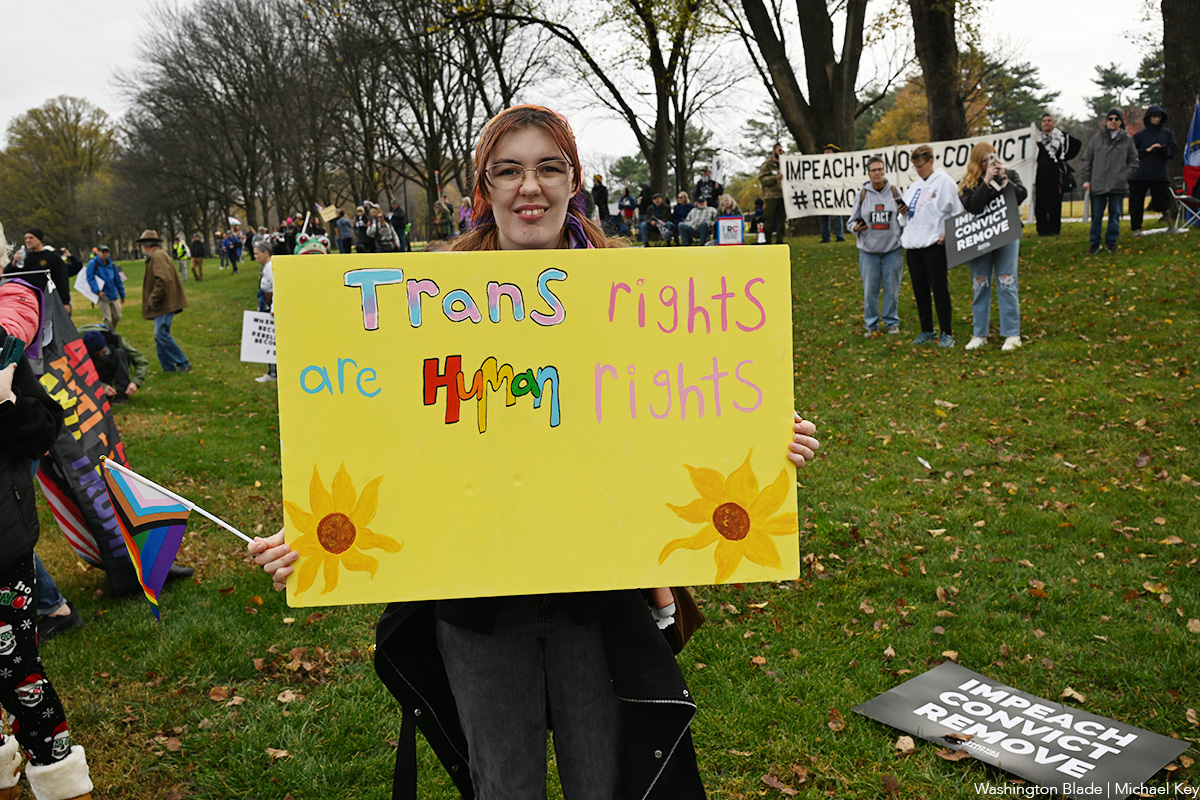




-

 District of Columbia1 day ago
District of Columbia1 day agoBowser announces she will not seek fourth term as mayor
-

 U.S. Military/Pentagon2 days ago
U.S. Military/Pentagon2 days agoPentagon moves to break with Boy Scouts over LGBTQ and gender inclusion
-

 Drag2 days ago
Drag2 days agoPattie Gonia calls out Hegseth’s anti-LGBTQ policies — while doing better pull-ups
-

 District of Columbia3 days ago
District of Columbia3 days agoSecond gay candidate announces run for Ward 1 D.C. Council seat

